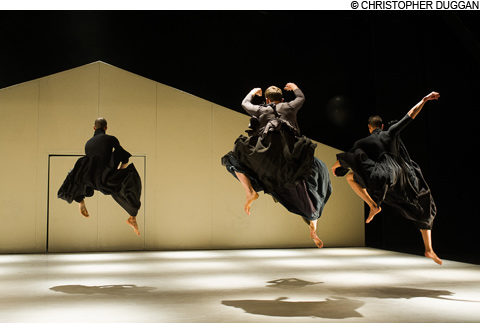
"THE SITUATION" The fierce gestures of the community depicted in Vertigo Dance Company's Mana
seem to be caught in the vise of obsessive memory. |
In 2005, graffiti artist Banksy stenciled the Palestinian side of the concrete separation barrier between Israel and Gaza with the dark silhouette of a little girl lofted upward by a bouquet of balloons. Not all creative work by Israelis addresses hamatzav, "the situation," and it exasperates artists when foreigners assume it does, but I recalled Banksy's emblem while watching Jerusalem-based Vertigo Dance Company's superb Mana (2009) at Jacob's Pillow's Ted Shawn Theatre last week. While the program notes spoke of mystical vessels of light — something choreographer Noa Wertheim associates with the human body — this profoundly ritualistic work, bounded by the outline of a squat house with a central doorway, seemed, in the insight of Pillow Scholar-in-Residence Philip Szporer, imprinted with states of partition.
Wertheim, who was born in the United States and grew up in Israel, comes from a religious family. The women's headscarves hint at time and place, but otherwise these figures in shredded and tied charcoal robes (by Rakefet Levy) could be any community seeking transcendence while living with the present reality of each other. They haul invisible burdens, draw their elbows together like bellows, and take space-gobbling skips and huge, canted leaps. Dani Fishof-Magenta's light spears through the action and reinforces the graphic nature of the decor, while Ran Bagno's score chimes with waltz-time carnival tones.
Then Rina Wertheim-Koren minces between the ensemble and the looming building with a single black helium balloon tracking above her like a thundercloud. Even while she is partnered in a clutching, spinning duet, the balloon demands attention as it bobs above the pair. There's a stunning male duet between Nitsan Margaliot and Eyal Vizner, who fly across each other's backs in what could be antagonism or robust intimacy; heterosexual couples switching coldly between social dance and mechanistic coitus; and Emmy Wielunski, crawling like an exhausted explorer across paving stones of light. By the end of the hour, the fierce gestures of this reassembled community seem to be caught in the vise of obsessive memory.
(Incidently, Mana will make an interesting "Varieties of Religious Experience" comparison with the reprise of Finnish choreographer Tero Saarinen's gorgeous Shaker-themed Borrowed Light, with live music by the Boston Camerata, at the Pillow next week.)
Lee Sher and Saar Harari, the married couple whose first names blur into the name of their New York-based company, LeeSaar, are also Israeli, but Fame, the 2012 work they brought to the Pillow's Doris Duke Theatre, looks to the imagined world of global celebrity. There's keen irony in the fact that these dancers base their work in Ohad Naharin's Gaga technique, which is practiced without mirrors. In Fame, everyone is looking for reflected approval.
Harari, a man with the pliant physique of a lizard, saunters and twitches wearing tighty-whities and a white cowboy hat; Hyerin Lee fences with a chopstick; Sher lip-synchs into a microphone; and Jye-Hwei Lin inches across the floor clutching a revolver. (A killer? A murder victim? Is she in a movie?) These lucid performers, and the rest of the LeeSaar company members, are a pleasure to watch. Unfortunately, Fame's critique of public narcissism is embedded in a random collage. I expect fame to be fleeting; I don't expect it to be channel- or Web-surfing.